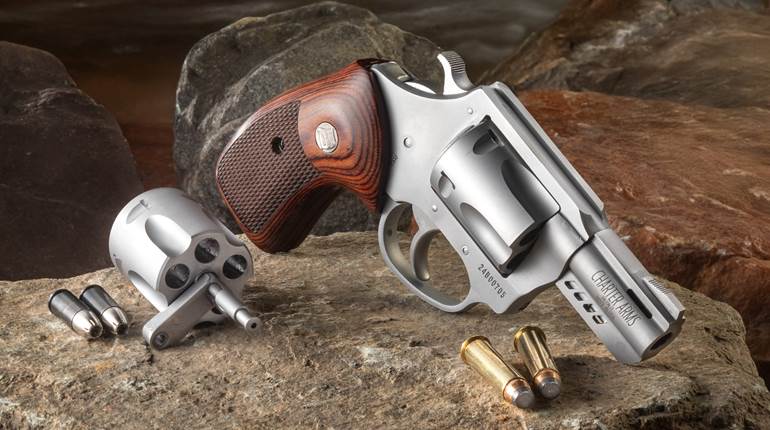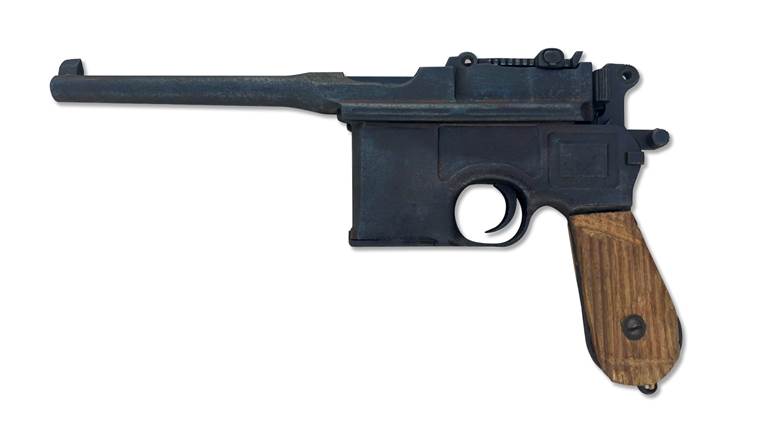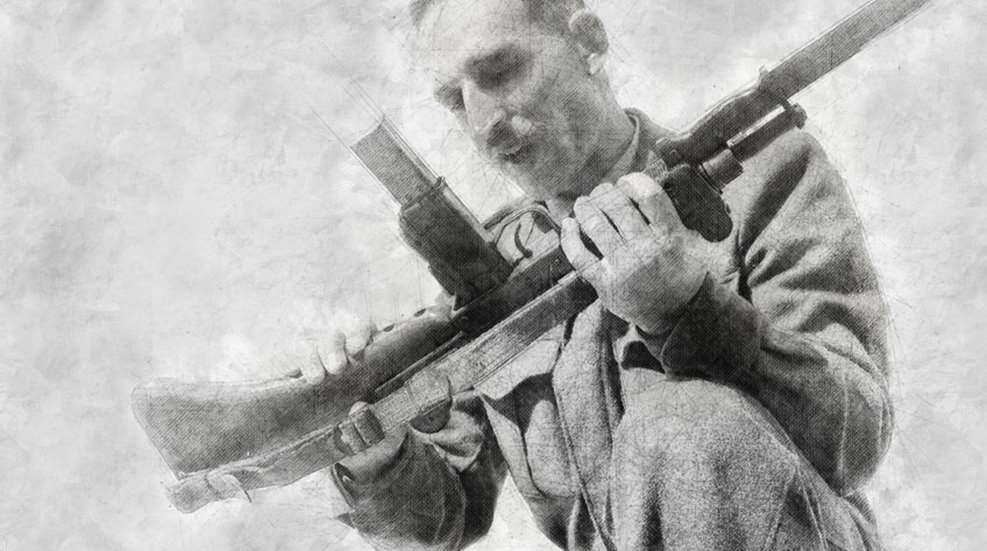
Uziel Gal examines his submachine gun in 1956, two years after it was adopted by the Israel Defense Forces.
The general history of the Uzi is well-understood. The 9 mm Luger submachine gun was designed by Uziel Gal in 1950 for Israel Military Industries (IMI), and was put into full production in 1954. Exports from IMI, together with FN sales of its licensed copy, led to the Uzi being adopted in some form by nearly half the countries on the planet—an impressive accomplishment. The gun’s unique profile makes it immediately recognizable, even in the shadowy background of a feature film, but someone interested in buying an Uzi soon realizes that not all Uzis are the same. Whether you’re a collector, a competitive shooter or a plinker, you’ll have to sort out a confusing list of manufacturers and model numbers to get the right gun for your needs. Let’s take a look at what’s available.
The Full-Automatics
If you’re looking for a full-automatic Uzi, an original factory IMI is the gun everyone hopes to find. Unfortunately, the only factory IMI Uzis that are transferable to civilians are those imported and registered prior to the 1968 Gun Control Act. An original FN Uzi is equally desirable but has the same restrictions. With fewer than 100 of these guns available, expect to pay a substantial premium if you’re lucky enough to find one of these rare collectables. If you find a factory IMI Uzi submachine gun with the Action Arms import stamp on it, you know that it’s not a transferable pre-1968 gun, because Action Arms didn’t exist prior to 1979. Norinco produced an unlicensed copy of the Uzi submachine gun, as did Arma Grupa in Croatia, but civilian transferable copies of those guns aren’t available in the United Sates, so you can take them off your shopping list. That leaves a buyer with three primary options when buying a full-automatic Uzi.

In the 1980s, Mike Brown started a gunsmithing business called Group Industries. His primary focus was converting semi-automatic firearms to full-automatic, which could be done for civilians at that time. Everything changed on May 19, 1986, with the signing of the McClure-Volkmer Act, which restricted all newly manufactured machine guns to law enforcement and machine gun dealers. In the short time between the House of Representatives passing the bill and President Reagan signing it into law, Brown made a set of stamping dies, stamped out slightly more than 4,000 Uzi receivers and registered them as transferable machine guns. That gave him a large inventory of machine gun receivers to fuel his business for many years. Unfortunately, Brown assembled only about 700 of the guns before a legal battle with his business partner forced the company into bankruptcy.
The Group Industries Uzi is a good choice for both shooters and collectors. The gun is easily identifiable by the large “Group Industries” logo on the left side of the receiver below the rear sight. The heat-treated receivers are meant to provide additional durability, and one can expect a lifetime of shooting enjoyment from this Uzi. The “HR4332” marking on the left side of the receiver is the gun’s model number, not a serial number. Brown chose the number because it was the number of the House of Representatives bill that ended the production of machine guns for civilians. The biggest problem with the Group Industries guns is that their receivers are slightly out of spec. In the rush to get his stamping dies completed before the McClure-Volkmer Act was signed into law, Brown didn’t get them exactly right, particularly in the area that holds the barrel trunnion. The heat-treating process made the problem worse because it tended to warp the receivers. Anyone building a gun with these receivers had to carefully overcome these inaccuracies during the build process, and Group Industries did a good job of it. Barrel alignment can sometimes be an issue with these Uzis, but a competent Uzi gunsmith can cure the problem.
Group Industries manufactured all its own parts for the Uzi, not just the receivers. While most of the parts are close to original IMI specs, variances in the extractor, the bolt and the top cover can sometimes cause feeding and ejection problems. Replacement of those parts with original IMI parts can go a long way toward resolving any problems encountered.
The remaining 3,300 Group Industries receivers were purchased at auction by Ralf Merrill in 1995. Merrill formed a company called Vector Arms and set to work building the receivers into transferable Uzis. For someone interested in purchasing a full-automatic Uzi, a gun from Vector Arms is the one of the most common options available. Vector used demilled South African Uzis for parts to complete its full-automatic guns. The South African parts closely followed IMI specs and were in new condition, so they were an excellent choice. Vector chose to heat-treat the Group Industries receivers in exactly the same way as the original Group Industries guns, giving them added durability. However, Vector had to work around the same receiver dimension problems and warping problems, resulting in similar barrel alignment concerns. Most of the guns ran fine, and the excellent customer service Vector provided addressed any problems that did arise. Vector guns are great workhorses if you’re looking for a shooter.
One of the biggest points of confusion for a buyer is how to tell the difference between a Vector Uzi and a Group Industries Uzi, since they are both stamped with the Group Industries name and logo on the left side of the receiver. A closer look at the receiver will show that Vector added its own name to the receiver, usually above the grip frame on the left side. Many classified ads for a Vector Uzi are incorrectly labeled Group Industries, so it’s a good idea to check the gun carefully to confirm what you’re getting. It’s valuable to note that if barrel alignment issues come up with either a Vector Arms or Group Industries Uzi, repairing the problem is almost always a permanent fix and the owner doesn’t have to worry about ongoing issues. Both guns generally accept surplus IMI parts, though the receiver discrepancies sometimes require special fitting of accessories such as a wooden stock or Picatinny rails.
The third option for those shopping for a lawful Uzi submachine gun is an IMI conversion. Action Arms began importation of a semi-automatic version of the Uzi in 1980. The guns were made by IMI in Israel and were the same outstanding quality as the IMI submachine gun. Until the McClure-Volkmer Act was passed in 1986, these guns could be converted to full-automatic for civilian use if the proper paperwork was approved by the ATF. Thousands of these guns were converted during that time frame, and they now make up a significant portion of the transferable Uzi submachine guns in the United States. The trick to buying one of these IMI conversion guns is to understand how it was registered and converted. The particular conversion technique used affects the value of the gun, the compatibility with surplus parts, the rate of fire and the ability to use cartridge conversions.
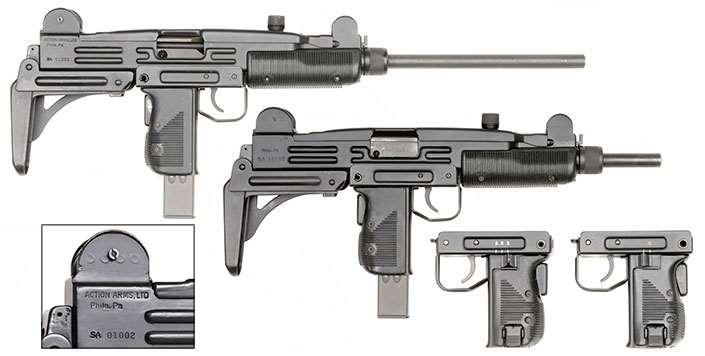
There are three primary variants of IMI conversion guns: registered receivers, registered bolts and registered sears. The details of each conversion method are beyond the scope of this article, but online resources such as the Uzi reference library at uzitalk.com provide buyers with enough information to make an informed purchase. Generally speaking, a registered-receiver conversion will give the most flexibility and commands the highest price. In fact, a properly converted registered-receiver Uzi is the only option a buyer can reasonably hope to find that would be the equivalent quality of an IMI-factory Uzi submachine gun. If the conversion was done properly, it can be difficult to differentiate a conversion gun from a factory full-automatic. The easiest way to tell is to check the serial number. If it has an “SA” prefix, then the gun started life as a semi-automatic IMI Uzi. Unlike a Group Industries or Vector gun, an IMI conversion may not be compatible with all surplus parts if the conversion was not complete. Do your homework before buying one of these guns.
The Semi-Automatics
As much fun as a full-automatic Uzi would be, not every state permits ownership of them, and not everyone has the financial resources to buy one. For many people, a semi-automatic Uzi is a more practical way to own one of these legendary firearms. There are plenty of good reasons to own a semi-automatic Uzi. Their 16" barrels provide good accuracy at longer ranges, making the guns fun plinkers. They are also an excellent choice for people competing in the rifle division of USPSA matches. Here’s a rundown of the many options available.
The IMI Uzi carbine imported by Action Arms from 1980 to 1989 is the gold standard of semi-automatic Uzis. The gun was designed by Uziel Gal in the late 1970s while he lived in the United States and worked for a company named Action Manufacturing. He designed a new closed-bolt mechanism for the Uzi and implemented a series of changes that were needed to obtain ATF approval. IMI in Israel manufactured the semi-automatic carbine and Action Manufacturing created a new subsidiary named Action Arms to import the guns and distribute them in North America. With the exception of the required 16" barrel and the semi-automatic-only functionality, the IMI Uzi carbine is the same as the legendary Uzi used around the world.
Action Arms imported approximately 80,000 of the semi-automatic Uzis, half of which were designated Model A, and half were designated Model B. Buyers will find the model designation clearly stamped on the left side of the receiver. The Model B had updated sights that were easier to adjust, and it had a new firing pin safety that ensured the gun wouldn’t fire if a round wasn’t fully seated in the chamber. Otherwise, the two models were identical. Action Arms also imported a Model 45 and Model 41, which were just Model B carbines chambered in different cartridges. Imports of the IMI semi-automatic Uzi ended in 1989 with the ban on the importation of non-sporting rifles. Even though it’s been nearly 30 years since then, used copies of the gun can be readily found at gun shops, gun shows and auction sites. If you want an original Israeli gun, there are plenty of them out there. Prices on these guns reflect their limited availability, and you can expect to pay twice as much for an IMI Uzi carbine as you would for any other brand.
Price is the primary reason for considering any brand other than IMI when it comes to a semi-automatic Uzi, and there are a number of options available to save money. In the 1980s, Mike Brown of Group Industries started making copies of the Uzi carbine when legal battles with his business partner slowed down production of his full-automatic Uzi. Brown used the same stamping dies he used to stamp his full-automatic receivers, and therefore the semi-automatic receivers had the same dimensional problems that had to be overcome when building the rifle. He changed the model number to HR4332S to identify it as having a semi-automatic receiver, and he heat-treated the receiver and all parts in the same fashion as he had done for his full-automatic Uzi. The Group Industries Uzi carbine is a faithful recreation of the IMI Model A carbine but also included the firing pin safety found on the Model B. The Group Industries guns are high-quality rifles that will provide a lifetime of shooting fun, but will possibly need some barrel alignment to overcome feeding and ejection problems. Brown stamped out nearly 20,000 of the semi-automatic receivers, but very few of them were assembled. In addition to being a great shooter, an original Group Industries Uzi carbine has a little bit of collector value because of its rarity.

Norinco in China manufactured an unlicensed copy of the IMI Uzi carbine in the 1980s, but importation into the United States was blocked because the gun infringed on patents held by Action Arms. Just more than 10,000 of the guns were finally imported in 1994 after they were modified to bypass the U.S. ban on non-sporting rifles. The biggest change made was the replacement of the folding stock with a wooden stock. A thumbhole-style stock was a popular mechanism used in the 1990s to re-classify rifles as sporting arms. Fit and finish on Norinco Uzi are rough, but the guns are functional and make good shooters. Feeding and ejection problems are not uncommon with the Norinco, but they are easily fixed by adjusting the top cover gap, or, in some cases, by replacing a few parts with original IMI parts. The Norinco Uzi originally sold for the same retail price as the IMI Uzi carbine, but sluggish sales resulted in many of them being sold to CDNN Sports. The Texas distributor then blew out the guns at very low prices and, suddenly, the gun shows were awash with Uzi carbines for $350. After the sunset of the U.S. assault rifle ban in 2004, it became popular to convert these guns back to their original form by installing a folding stock and the required number of U.S.-made parts. The Norinco is an economical way to get into the Uzi game.
Many of the unassembled receivers manufactured by Group Industries found their way to Vector Arms, where they were built into complete Uzi carbines. Unlike the Vector submachine guns that were built with a consistent set of parts, the Vector carbines were built with parts from multiple vendors that varied over time. Some surplus IMI parts were used, but many parts were sourced from local manufacturers. Despite some consistency issues with the parts used, the semi-automatic Vectors are generally great shooters and have excellent fit and finish. Barrel-alignment problems did happen occasionally due to the dimension issues with the Group Industries receivers used, but they were infrequent. Just like with the full-automatic version, a semi-automatic Vector will have both Group Industries and Vector markings on the receiver. Check the markings carefully before you buy to ensure you get the gun you’re looking for.
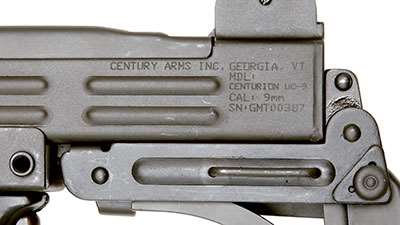
Vector also obtained a limited number of IMI receivers and built them into complete Uzi carbines. The receivers have Action Arms import markings on them but were never actually imported by Action Arms. These excellent carbines were in high demand when Vector had them, but the supply ran out quickly. Vector semi-automatic Uzis are typically priced mid-way between a Norinco and an IMI. A Vector with an IMI receiver will command a premium over a Vector with a Group Industries receiver.
Another Uzi carbine available is the Century Centurion UC-9, made between 2010 and 2015. They were made from receivers stamped by Global Machine and Tool in Texas, which were very accurate reproductions of the original IMI receivers. Century used a combination of surplus Uzi parts from the German army and parts manufactured by U.S. vendors. The guns are consistent with other offerings from Century, providing a functional, low-cost Uzi with fit and finish that are a little rougher than other Uzi carbines. Many UC-9s require some tinkering for proper functioning.
Other Variants
One final option to consider is the Walther Uzi. This .22 Long Rifle copy of the Uzi carbine was made from 2012 to 2015. The guns were made under license from IWI in Israel and have IWI markings on the receiver, but IWI was not involved in its manufacture. Walther did an excellent job making the exterior of the gun look like an original Uzi, while completely re-designing the internal components to function properly with the .22 Long Rifle cartridge. The rifle version of the Walther Uzi comes with a fake suppressor to hide the 18" barrel. None of the surplus Uzi parts on the market are compatible with the Walther Uzi.
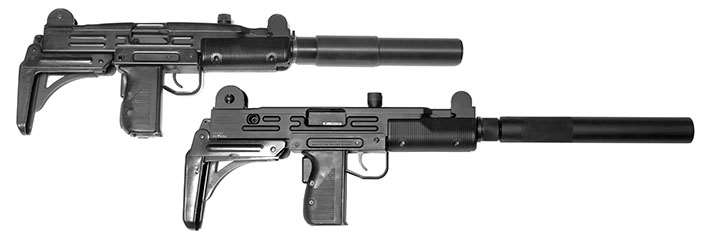
After more than six decades, the Uzi remains a desirable firearm for both collectors and shooters. There are many guns available on the used market, replacement parts are plentiful, they’re inexpensive to shoot and the guns are extremely durable. Understanding the different models available allows buyers to find guns that meets their specific needs. If one Uzi isn’t enough, a buyer can start shopping for other Uzi variations including the Mini Uzi, the Micro Uzi and the Uzi pistol—the latter is currently imported by IWI US in Middletown, Pa. There’s a lot of history and shooting enjoyment to be experienced with an Uzi!
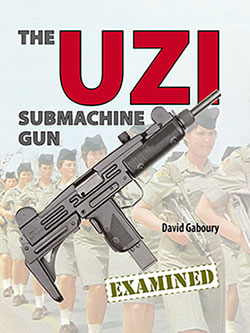 “The Uzi Submachine Gun Examined”
“The Uzi Submachine Gun Examined”
Even though the Uzi is one of the most recognizable and iconic firearms of all time, the Uzi is really a series of guns made not only in Israel, but also in the Netherlands, Germany, Belgium, South Africa, China and even the United States.
Enthusiast David Gaboury has produced a book that is a testament to the original inventor, Uziel Gal, but also a fine description of the origins of Israeli small arms, and the Uzi’s design evolution, adoption and service with Israeli Defence Force. Gaboury then moves on to the guns made both under and without license in other countries. Of particular interest to collectors is his painstaking description of both the full-automatic and semi-automatic guns residing in the United Sates today. Interested in an Uzi? Buy this book first.
The 8½"x11" hardcover book has 304 pps. and more than 1,000 black & white photos. It is available from Mowbray Publishing; (401) 597-5055; gunandswordcollector.com. The price is 49.95 plus $4.50 shipping.












